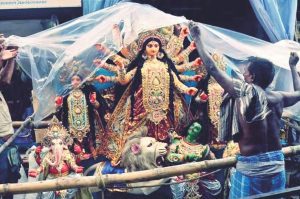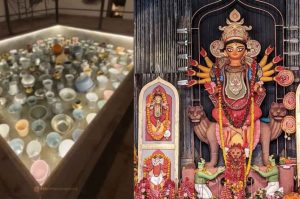Covered Pandals Minimize Rain Damage: The 2025 edition of Kolkata’s Durga Puja, a festival globally recognized by UNESCO as Intangible Cultural Heritage, has seen an unusual clash with seasonal rains. With the puja dates coinciding with lingering monsoon showers and even warnings of cyclonic disturbances, puja organizers faced the perennial challenge of safeguarding intricate artworks, pandal structures, and visitor arrangements.

This year, the emphasis has shifted dramatically toward covered pandals with indoor themes, and the outcome has been striking—while many open-air pujas struggled with water damage and repairs, those opting for weather-proofing reported minimal disruptions. The phrase “covered pandals minimize rain damage” has become a talking point across organizing committees, urban designers, and even among visitors who experienced smoother darshan at these protected venues.
Why Covered Pandals Made the Difference
Durga Puja pandals are traditionally temporary but elaborate structures made of bamboo, wood, cloth, thermocol, and other materials. Rainfall often soaks fabric backdrops, weakens bamboo frameworks, and damages electronic lighting systems.


By moving toward indoor-styled, enclosed structures, committees ensured:
- Better protection of artworks such as clay idols, murals, and installations.
- Reduced maintenance and repair costs, avoiding last-minute patchwork.
- Safer visitor experience with fewer slippery surfaces and collapsed platforms.
- Improved drainage management, since enclosed pandals allowed committees to design controlled entry and exit points.
Covered Pandals Minimize Rain Damage: Examples of Committees That Benefited
- Behala Club chose an “adda” (Bengali conversation circle) theme, built entirely indoors with clay installations and roofs shielding every section. Their decision, taken as early as April, saved nearly ₹65 lakh worth of décor from potential ruin.
- Ajeya Sanhati, Haridevpur, one of South Kolkata’s well-known pujas, reported almost no damage despite continuous rain, thanks to their fully covered pandal.
- Prafullakanan Adhibasibrinda, Kestopur, designed by artist Krishanu Pal, used bamboo, iron, and brick-based canopy covers to house delicate artwork inside. Their pandal opened on schedule with virtually no rain-related disruptions.
- Artists like Susanta Paul and Rintu Das also emphasized “internal-first” designs, placing installations inside rather than projecting them outside where they could be damaged.
In contrast, large-scale open-air park pujas faced repeated waterlogging, damaged pathways, and fragile displays. Visitors often reported inconvenience, whereas covered-pandal visitors had a smoother experience.
Technical and Design Innovations
- Material Choices – Stronger iron-bamboo frameworks, reinforced tarpaulin, and canopy roofing became standard in covered pandals.
- Drainage Systems – Pumps were deployed in advance to remove stagnant water.
- Aesthetic Adjustments – Instead of vast outdoor facades, artists redirected creativity into interior lighting, murals, interactive sculptures, and soundscapes.
- Budget Prioritization – Money saved from avoiding rework and rain damage was redirected into digital displays and enhanced lighting effects.
Broader Cultural and Urban Implications
The resilience shown by covered pandals this year reflects a larger cultural shift: Kolkata’s puja committees are learning to adapt to climate volatility. As monsoons grow unpredictable and intense, festival infrastructure is expected to integrate climate-conscious design principles.
- For committees: The upfront investment in enclosed structures is now seen as an economic safeguard.
- For visitors: Safer walkways and undisturbed viewing experiences mean higher satisfaction and greater turnout.
- For artists: The push towards indoor creativity may open new avenues of innovation, with immersive, museum-like pandal experiences becoming more common.
Urban planners also see this trend as part of a climate resilience model for temporary architecture, where festivals not only entertain but also demonstrate best practices in sustainable, adaptive design.
Voices from Organizers
- “We had anticipated rain during Puja and shifted entirely to covered arrangements. That foresight saved us,” said Sayantan Bhattacharjee of Behala Club.
- “Even with cyclone warnings, we were confident because our structure was designed to withstand weather shocks,” noted Rahul Shaw of Ajeya Sanhati.
- “Our artist’s insistence on an indoor concept proved right—we faced almost no damage,” said Ranjit Chakraborty of Prafullakanan.
Looking Ahead
With the success of covered pandals this year, it is likely that many more committees will adopt similar weather-proofing in the future. The balance between aesthetics and resilience will define the next era of Durga Puja artistry. Committees may even collaborate with structural engineers, architects, and environmental experts to ensure both safety and creativity flourish together.
External References
- UNESCO on Durga Puja’s Intangible Cultural Heritage status
- India Meteorological Department – Regional Weather Forecasts
- West Bengal State Disaster Management Authority
- Kolkata Municipal Corporation – Festival Guidelines
Also read: Home | Channel 6 Network – Latest News, Breaking Updates: Politics, Business, Tech & More

